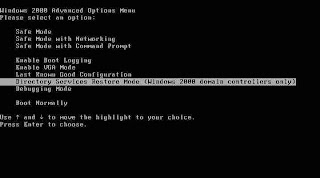1.Reboot the computer
2.During startup, press F8 when prompted to, and then select Directory Services Restore Mode (Windows DCs only) from the Windows Advanced Options menu. Press Enter.
3.Choose the operating system that should be started. Press Enter
4.When the Safe Mode logon prompt appears, enter the appropriate local administrator account information, and then click OK.
5.Click OK when a messag e appears, advising that Windows is running in Safe Mode
e appears, advising that Windows is running in Safe Mode
6.Click Start, All Programs, Accessories, System Tools, and then click Backup.
7.On the initial page of the Backup or Restore Wizard, click Next
8.Ensure that the Restore files and settings option is selected on the Backup Or Restore page. Click Next. 9.On the What to Restore page, choose the backup which you want to use for the restore process. Click Next.
10.Click Finish to immediately start a normal restore of Active Directory. If you want to configure advanced option settings, click Advanced, and not the Finish button.
11.When the Where to Restore page appears, choose one of the following optios from the Restore files to list box
13.Click OK if a message is displayed, warning you that a restore of system state data overwrites existing system state data.
14.When the How to Restore page opens, choose between the following options:
16.When the Advanced Restore Options page is displayed, you can select the following options
18.Click Finish to start the Normal Restore of Active Directory.
2.During startup, press F8 when prompted to, and then select Directory Services Restore Mode (Windows DCs only) from the Windows Advanced Options menu. Press Enter.
3.Choose the operating system that should be started. Press Enter
4.When the Safe Mode logon prompt appears, enter the appropriate local administrator account information, and then click OK.
5.Click OK when a messag
 e appears, advising that Windows is running in Safe Mode
e appears, advising that Windows is running in Safe Mode6.Click Start, All Programs, Accessories, System Tools, and then click Backup.
7.On the initial page of the Backup or Restore Wizard, click Next
8.Ensure that the Restore files and settings option is selected on the Backup Or Restore page. Click Next. 9.On the What to Restore page, choose the backup which you want to use for the restore process. Click Next.
10.Click Finish to immediately start a normal restore of Active Directory. If you want to configure advanced option settings, click Advanced, and not the Finish button.
11.When the Where to Restore page appears, choose one of the following optios from the Restore files to list box
- Original location, this default setting restores files to their original locations
- Alternate location, if selected, you can specify a different location to which the files should be restored.
- Single folder; this option restores files to a single directory.
13.Click OK if a message is displayed, warning you that a restore of system state data overwrites existing system state data.
14.When the How to Restore page opens, choose between the following options:
- Leave existing files (Recommended); select this option if you do not want the restore to overwrite any existing files.
- Replace existing files if they are older than the backup files; if selected, files older than the backup files are replaced.
- Replace existing files; this option replaces all existing files with the backup files
16.When the Advanced Restore Options page is displayed, you can select the following options
- Restore security settings; is enabled by default. If you disable this checkbox, all files would be restored without any permissions.
- Restore junction points, but not the folders and file data they reference; when selected, the restore process is able to restore information on mounted drives.
- Preserve existing volume mount points; when selected, existing mounts are protected on the volume. Restore the Cluster Registry to the quorum disk and all other nodes; if applicable for this domain controller, the cluster quorum database is restored.
- When restoring replicated data sets, mark the restored data as the primary data for all replicas; this option should be enabled if you are performing a Primary restore of Active Directory.
18.Click Finish to start the Normal Restore of Active Directory.
















0 comments:
Post a Comment